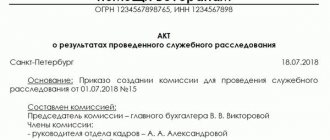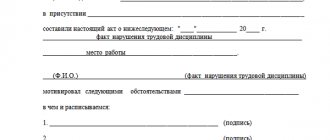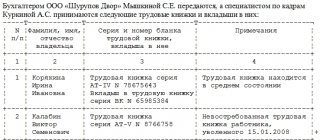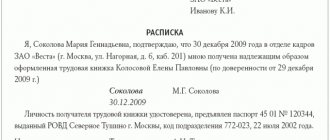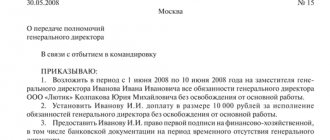What do you mean by truancy?
In practice, it happens that employees do not come to work or leave the workplace without permission. If there are no valid reasons for absence from the workplace, then this is considered absenteeism (subparagraph “a”, paragraph 6, part 1, article 81 of the Labor Code of the Russian Federation). So, for example, absenteeism is absence from work:
- throughout the entire working day (shift), regardless of its duration;
- more than four consecutive hours during a work day or shift.
Absenteeism is a gross violation of labor discipline, which is punishable by dismissal. Moreover, you can fire an employee even for a single fact of absenteeism (“Dismissal for absenteeism: sample order for 2017”). An exception to this rule is absenteeism during pregnancy. A pregnant woman cannot be fired on this basis under any circumstances (“Pregnant Absenteeism”).
Let us remind you that the following situations are considered absenteeism:
- the employee went on vacation without permission or used his available days off without permission from the employer;
- the employee did not warn the employer about his voluntary dismissal.
general information
When an employee ignores job responsibilities and is absent from the workplace at the required time, it is important for management not to rush to make hasty decisions, but to figure out whether the disciplinary offense occurs on the initiative of the employee or due to circumstances beyond the control of the parties.
If an incident occurs, the procedure is as follows:
- Document the fact of absenteeism (a report is drawn up in the presence of witnesses or a report from the head of the unit).
- Request to provide an explanatory note in writing.
- If the reason for absence is valid, the internal investigation is closed. Otherwise (and also in the absence of explanations), an appropriate act is drawn up and a decision on punishment is made.
- If the employer decides to terminate the employment relationship due to absenteeism, an order is prepared and an entry is made in the work book.
- A notification is sent (optional procedure).
A notice letter of dismissal is a document sent to an employee to inform them of the termination of an employment contract.
Reasons for referral may be:
- the employee is absent from the workplace for more than four hours in a row without a valid reason;
- unauthorized leaving work earlier than expected;
- refusal to work.
The legislation does not establish a list of valid reasons, so the manager makes the decision independently.
Judicial practice shows that these include:
- days of illness (a certificate of incapacity for work is required);
- performance of state or public duties (served as a juror, attesting witness, etc.);
- days of medical examination and blood donation (for donor).
In some cases, average earnings for days of absence are provided.
Dismissal for absenteeism is a serious conflict, so the management of the organization should not rush to formalize the termination of the employment contract. If the decision turns out to be unfair or the formalities are not completed correctly, the employee has the right to contact the labor inspectorate.
Therefore, first of all, a notification is issued with a request to provide the reason for the offense.
Employee does not go to work
It happens that an employee is absent from work for a long time without explanation. In such a situation, you need to send a notice to the employee about the need to appear to provide explanations. How to send a notification correctly? After all, if you do not comply with current legislation, the document will not be considered sent to the employee.
It turns out that the personnel officer who compiled the document is faced with the question of what letter to send the notification of the need to report to work?
Let us say right away that the notification of the need to appear to give explanations must be sent to the employee’s home address by a valuable letter with a list of the contents and a receipt. The text of the letter should ask the employee to come to work and explain the reason for his absence from the workplace or send written explanations to the employer within the deadline proposed to the employee.
Failure by an employee to receive notice of the need to come to work to provide explanations cannot be an obstacle to dismissing an employee for absenteeism. The main thing is to give the employee time to respond in writing. If after this period a written response is not received or the employee does not show up for work, a statement of lack of explanation should be drawn up signed by two or more witnesses. The next stage will be the dismissal of an employee for absenteeism (Part 2 of Article 193 of the Labor Code of the Russian Federation, appeal ruling of the Ulyanovsk Regional Court dated July 15, 2014 No. 33-2339/2014).
It is clear that the current legislation does not establish a single form for notification of the need to report to work. A sample notification letter prepared by our specialists will help HR specialists save time on developing their own form.
If you find an error, please select a piece of text and press Ctrl+Enter.
Source of the article: https://blogkadrovika.ru/uvedom-o-neobhod-yavki-na-rabot/
At what stage is the letter written?
Let's consider the algorithm of actions of the organization's management when dismissing an employee for absenteeism:
- Proof of the employee's absence must be taken care of. For this purpose, an act is drawn up, which is certified by several witnesses. Other employees may be witnesses.
- The immediate supervisor of the dismissed person draws up a report addressed to the main head of the organization with an attached certificate of the employee’s absence from the workplace.
- In some cases, on the day of absenteeism, an order may be issued to schedule an official check, which is aimed at finding the absent person (calling relatives and friends).
- A notification letter is sent to the employee's address with a requirement to provide a written explanation within two days from the date of absence (excluding weekends).
- If there is no response to the notification, then a report on the lack of explanations on the part of the violator is drawn up, which is also certified by witnesses (Article 247 of the Labor Code of the Russian Federation).
- An order to apply a disciplinary sanction is issued (no later than a month), which is also sent to the employee against signature.
- A dismissal order is issued.
Notice of dismissal for absenteeism
Last modified: January 2020
Labor legislation provides for a rule that allows an employer to unilaterally terminate an employment relationship with an employee who is absent from work without a valid reason. The complexity of the procedure involves obtaining an explanation from the employee as to what was the reason for failure to appear and the assessment of the circumstances by management. A notice of dismissal for absenteeism is sent to the truant at the last stage of registration, when the administration has not received an explanatory note or other documents from the person within the established time frame.
What to do if an employee refuses to write an explanatory note?
If the employee refuses to explain the circumstances of the incident, the employer creates a commission that draws up an act certifying the employee’s refusal to write an explanatory note explaining his misconduct.
The act is signed by the employer, members of the commission who are employees of this enterprise. The date of its preparation must be indicated in the act. It is recorded in the internal document flow log and then transferred to the HR department for storage.
An order or instruction from the employer regarding readiness to use the right to impose a disciplinary sanction is presented to the employee within three days after the issuance of the order, excluding the time the employee is absent from the workplace.
Familiarization with the order is carried out against signature, therefore, if the employee does not want to sign, an appropriate act is drawn up.
Previous article: Job description of a leading engineer Next article: Sample memo for taxi payment
Features of dismissal of a truant
Unlike dismissal on personal initiative, parting with a truant worker requires compliance with regulations and going through stages that involve an attempt to communicate with the absentee and obtain an explanation.
Before dismissing a truant worker, you must make sure that his actions qualify as a violation of labor discipline and there is no reason to assume that there are objective valid reasons that forced the employee to be absent from the workplace.
The documentary basis for terminating a contract with a truant worker will be an official request for an explanation of the reasons for non-appearance, sent to the employee the day before. In the absence of feedback or provision of unclear explanations, management reserves the right to terminate the employment contract on the basis of Art. 81 labor legislation.
Despite the lack of clear explanations under what circumstances an employee has the right to be absent without prior agreement with the employer, there are clear indications of what is considered absenteeism, giving the right to unilateral termination of the contract:
- absence from work for the whole day; 4-hour absence, excluding lunch time; violation of the working day regime established at the enterprise more than 3 times during the year.
The violator is dismissed with an entry in the work book with reference to clause 6, part 1 of Art. 81 Labor Code of the Russian Federation.
Sequencing
The procedure is presented in several stages:
- After absence from work, the administration records the fact of violation by drawing up an act, memo, or report.
- Based on the submitted document, management initiates proceedings and sends an official request to the absent person about the reasons for absence (according to Article 193 of the Labor Code of the Russian Federation).
- When receiving feedback, the explanations provided are reviewed to determine if the reason is valid. If they are considered disrespectful, or if no explanation is received from the employee, management decides to impose a penalty. An employee cannot be fired for a single absence from work; usually, they are limited to a reprimand. In case of systematic violations (3 times or more in the last year), the administration has the right, on its own initiative, to dismiss the truant.
- The manager orders the issuance of an order to terminate the contract with the offender and sends it to the employee for review.
- When an employee hides or refuses to sign a document, the relevant services of the enterprise draw up a statement of refusal.
- Next, they make the last entry in the employment record with reference to dismissal under the article, prepare payroll and documents for transmission to the employee.
Request for explanatory note
To do this, a letter is sent to the employee requesting an official explanatory note.
The structure of the request letter requires the indication of all important parameters and circumstances, but there is no separate form for such a document.
As a rule, the request is written in the following sequence:
- The number assigned during document registration.
- Date of preparation.
- Name of the form.
- Information about the organization (including addresses and contacts).
- Information about the recipient (position, full name, address).
- The main part with a statement of the fact of absence, recorded in the act, the duration of the absence, the wording “without specifying the reasons.”
- Next, they formulate a requirement to appear to give explanations within 2 days.
- In order to have grounds for subsequent dismissal, further in the text they warn about the consequences of ignoring the employer’s requirements.
- The document is signed by the head of the enterprise, indicating the position and decoding.
After drawing up the paper, a problem arises with conveying information to the attention of the absent employee. Since notice of dismissal for absenteeism requires urgent communication, a telegram or valuable letter of notification is sent to the absentee, or transmitted by e-mail or other means of telecommunication.
It is in the interests of the employer to find out the reason for the absence, since otherwise there is a risk of challenging the dismissal and filing a lawsuit demanding reinstatement and payment of compensation for the period of absence.
How to compose?
In content and form, a memo resembles a statement . Therefore, its structure is similar.
In the upper right corner you need to create a “header” indicating the data to whom and from whom.
Example:
“To the Director of OJSC “Kvadrat” Kondratyev Kondrat Kondratovich From the senior manager Nikolaev Nikolay Nikolaevich.”
The name of the structural unit is written in the upper left corner.
Example : “Sales department”.
Expert opinion
Semenov Alexander Vladimirovich
Legal consultant with 10 years of experience. Specializes in the field of civil law. Member of the Bar Association.
Heading in the middle. The top line is a memo, the bottom line is about the employee’s absence from the workplace. Both lines must be capitalized .
After the heading “Official (report) note” write the date and document number. Next, the fact of absence is stated, with a clear time period, and the clarified reasons for the absence.
Example: “I would like to bring to your attention that an employee of the sales department, Petrov Petrovich, was absent from the workplace on May 5, 2017, for the entire working day from 8 a.m. to 6 p.m. I took measures to find out the reason for the absence in the form of a call to Petrov’s mobile phone.
When he answered, he said that there was a water supply failure in his apartment, due to which he was forced to stay at home.”
Example : “Please take the stated facts into account and reprimand the sales department manager P.P. Petrov.”
Mitigating circumstances - the employee explained the reason for his absence with a valid reason, and also, if this happens for the first time, there are no other complaints. In this case, the originator may request that no disciplinary action be taken.
Example : “I ask you not to take disciplinary measures against the sales manager Petrov P.P., since such an incident happened for the first time, and the authenticity of the stated reason for absence is confirmed by a certificate from the Housing Office about the breakdown of the water supply system at Petrov’s residence address during the specified time of his absence.”
Aggravating facts - repeated or multiple absences from work, complaints about the performance of duties, etc. Such circumstances may become the basis for a reprimand, penalties, and even dismissal.
Example : “A similar situation has happened for the 4th time in the last six months, the previously indicated reasons for absence were not confirmed, and such behavior of P.P. Petrov. leads to disruption of work plans and losses.
In this regard, I ask you to fire sales manager P.P. Petrov. in accordance with paragraph.
6 tbsp. 81 of the Labor Code of the Russian Federation for absenteeism.”
At the end, the compiler indicates the position, personal data and signs . Between the statement of the fact of absenteeism and the request for the application of measures, there may be a paragraph with an analysis of the situation.
Example: “In the last 3 months Petrov P.P. I was often late for work and arrived with traces of a hangover.
From which I can conclude that Petrov’s absence from work is associated with excessive alcohol consumption and has no valid reasons.”
You can find out about the rules by which an official memo is drawn up, as well as see a sample document, in a separate material, and in detail about the rules for preparing official memos according to GOST, as well as what requirements apply to their writing, read here. .
How to fire someone for absenteeism
When a person is absent and there is no way to contact him, there remains a risk of subsequent revocation of dismissal. For this reason, the employer must make every effort to obtain written explanations from the truant.
- For each day of absence from work, prepare appropriate confirming acts signed by a special commission. Record no-show on the time sheet. Send notifications and keep copies of messages proving the facts of an attempt to contact the employee for proceedings.
If all conditions are met, in the absence of valid reasons for failure to appear, the employee will not be able to appeal management’s decision to dismiss. If the employer has fulfilled all the requirements under the law, the judge will lean towards the defendant, leaving the decision to terminate the contract in force.
The law prescribes
In Art. 57 of the Federal Law No. 90-FZ, Art. 192 and 193 of the Labor Code contain instructions that regulate the actions of the employer in requesting written explanations from employees who have committed unlawful acts and are guilty of not fulfilling their labor duties, violating labor discipline and labor regulations provided within the enterprise. Constitution of the Russian Federation in Art. 27 notes that the employee has the right to write an explanatory note, which cannot relate to the duty.
If an employee violates labor discipline by not performing or performing labor duties improperly, then the employer, by law, has the right to apply disciplinary punishment to him.
The measure of responsibility for the offense committed is classified as:
- remark, often made orally;
- a reprimand, depending on the aggravating circumstances, it is presented orally or in writing;
- dismissal from work with appropriate wording on the grounds specified in regulations and the Labor Code.
But, before exercising the right to impose a disciplinary sanction, the employer is obliged to request from the employee an explanation explaining the basis of his action, which led to violations of the rules of labor conduct, verbally or in writing.
A written explanation is used only in some cases, for example, if the validity of the reasons that formed the basis of his duty and led to a violation of labor discipline is assessed. In each specific case of an offense, it is necessary to carefully understand it, therefore the explanatory note argues for the details, explains the details of what was done and brings to the attention of management the employee’s opinion and his ability to analyze the current situation.
If the employee does not provide an explanatory note within two working days, then, in accordance with the instructions of the current legislation, a statement of failure to submit is drawn up, which will not become an obstacle to the application of suitable disciplinary punishment by the employer.
The number of personnel should be calculated based on feasibility.
See how to create a staffing schedule for a construction organization. The manager's reference for awards must contain positive information. Read more in the article.
Circumstances
The employee is obliged to explain the reasons that prompted him to commit this or that offense associated with failure to comply with the requirements for fulfilling official duties.
The circumstances are different, but they all lead to a certain type of violation of labor discipline and routine:
- being late for work for a good or bad reason, the reason must be clearly defined;
- failure to fulfill direct functional duties or their performance not in accordance with the requirements of the duties, for example, the work is performed poorly and therefore does not bring good results;
- absence from work during working hours without appropriate documents justifying his misconduct; a medical certificate certifying the employee’s illness can serve as an exculpatory document;
- damage to the employer’s property associated with negligence in the performance of work duties;
- failure to fulfill an order issued by the employer, which is not part of the direct duties of the employee;
- being at work in a state of intoxication from the influence of alcohol, drugs and toxic substances, which will entail failure to fulfill accepted obligations to comply with labor safety rules;
- failure to provide reliable information about the production activities of the enterprise to senior management, which leads to economic violations;
- in case of violation of life safety rules provided for at the enterprise.
Regardless of the circumstances, when an employee provides supporting documents attached to the explanatory note, the decision that is made in connection with the offense is mitigated.
Who has the right to request?
According to the current laws and provisions of the Labor Code of the Russian Federation, only the employer has the right to request an explanatory note. He must hold the position of the head of the enterprise or a person authorized by the head, approved by order of the enterprise for a certain period.
The requirement to write an explanatory note is an integral part of engaging an employee to comply with disciplinary liability in the workplace and on the territory of the enterprise.
The explanatory note helps the employer to find out the circumstances due to which the offense was committed and the degree of guilt of the employee. The employer, realistically assessing the situation, makes a decision on the appropriate disciplinary measure and the need to take it.
Is the employee required to answer?
The employee has the right to refuse to write an explanatory note because it directly or indirectly confirms his guilt. But often the best option may be to provide an explanatory note to avoid more severe punishment in the form of fines or dismissal from work.
An employee who receives an official letter notifying him of the requirement to provide an explanation responds to it regardless of which decision he chooses: “to write an explanatory letter or not.”
If he is not going to write it, he must notify the employer of the refusal. In any case, refusal to write an explanatory note is not considered an offense.
Notification structure
Despite the absence in labor legislation of an obligation to notify about the upcoming dismissal for absenteeism, the enterprise administration is recommended to do this, eliminating misunderstandings with the dismissed person in the future.
Notice of dismissal for absenteeism (form/sample) (32.0 KiB, 1,896 hits)
- name of the sending organization and information about it; information about the recipient-employee with position, full name and address; the name of the unit/department in which the person worked; The name of the paper must be indicated - “notification of dismissal” and the date of preparation of the document must be indicated; the main part sets out the reasons for dismissal and determines the date of termination of the employment relationship.
In life, it is impossible to foresee all the circumstances that forced a person not to go to work. Each situation is unique and it is possible that a person did not show up for work and did not receive notice for valid reasons. If it subsequently turns out that the citizen had every reason to be absent and provided documents, the court will annul the dismissal and reinstate the victim, forcing the employer to pay compensation.
Need some advice? directly on the site. All consultations are free / The quality and completeness of the lawyer’s response depends on how completely and clearly you describe your problem:
Source of the article: https://zakon-dostupno.ru/distsiplinarnaya-otvetstvennost/uvedomlenie-ob-uvolnenii-za-progul/
Grounds for dismissal
Additional explanations can be found in judicial practice, in particular, an employee can be dismissed in such cases (paragraph 39 of the resolution of the Plenum of the Armed Forces of the Russian Federation dated March 17, 2004 No. 2):
- absence from work without good reason, that is, absence from work throughout the entire working day (shift), regardless of the length of the working day (shift);
- an employee staying outside the workplace without good reason for more than four hours in a row during the working day;
- leaving work without a valid reason by an employee on an open-ended employment contract without warning the employer of termination of the contract;
- abandonment of work without a valid reason by a person who has entered into a fixed-term employment contract before the expiration of the contract;
- unauthorized use of time off or going on vacation (main, additional).
Reasons for absence from work
Workers are asked to take time off in most cases for several hours, sometimes for a day. The situation is not regulated in the Labor Code of the Russian Federation or other regulations, including labor law norms.
This means that they decide on the possibility of asking for time off and on how to write a statement for absence from work, taking into account specific circumstances. There are different reasons for taking time off from work; the employee receives permission from the employer in any case.
The boss is obliged (Article 128 of the Labor Code of the Russian Federation) to allow leaving the place of work if:
- you need to take time off for medical care;
- an emergency situation has arisen, including an emergency;
- the employee is invited to participate in the court hearing;
- registration of marriage or birth;
- death of a close family member;
- the employee belongs to the category of WWII veterans, disabled people, military family members, old-age pensioners who continue to work.
The employer should not, but has the opportunity to give the employee the opportunity to take time off from work due to family circumstances and other valid reasons - this is what Part 1 of Art. 128 Labor Code of the Russian Federation.
Recommendations to the employer in controversial cases
Position 1. The lunch break should be included in the 4-hour period of absenteeism. If this is not done, then it is almost impossible to fire an employee for absenteeism. The fact is that the Labor Code of the Russian Federation does not define a working day as working time before and after lunch. This means that a lunch break cannot interrupt the period provided for in Art. 81 of the Labor Code of the Russian Federation (sub-clause “a”, clause 6, part I).
Position 2. The lunch break is not included in the 4-hour period of absenteeism. Article 106 of the Labor Code of the Russian Federation classifies a break for meals as rest time. This means that the employee is free from performing work duties at this time. Absence from the workplace during this time cannot be blamed on the employee and may not result in disciplinary liability.
The second point of view is more common in judicial practice, but the final decision remains with the employer.
The next controversial issue is the validity of the reasons for absenteeism. Since the legislation does not contain a list of such reasons, the decision is made by the employer, aware of the possibility of verifying the validity of recognizing the reason for absenteeism as valid in court in the event of a dispute with the employee. It should be noted that in such cases, the courts take into account the severity of the employee’s offense, attitude towards work, the impact of the employee’s absence on the work process, and the circumstances of the offense. Judges considered the following reasons for an employee’s absence to be valid:
- participation in legal proceedings;
- unpaid leave due to an employee in accordance with the Labor Code of the Russian Federation;
- absenteeism from work after two weeks have elapsed since the employer’s written notice of the desire to resign;
- poor health (documented);
- illness of the child, which is confirmed by a doctor’s certificate, extracts from the medical record (even when the sick leave is opened only the next day);
- carrying out emergency repair work in the employee’s apartment (confirmed by a certificate from the HOA, housing office, etc.);
- the employee’s location on the way to the place of study and back;
- suspension of work due to the employer delaying payment of wages for more than 15 days (based on Article 142 of the Labor Code of the Russian Federation), even if the debt is partially repaid;
- serving an administrative punishment by an employee (administrative arrest).
If a dispute arises about the legality of dismissal, the employer must prove the fact of absenteeism. Therefore, it makes sense to resort to dismissal for absenteeism only if there is conclusive evidence that the reasons for absence from the workplace are not valid, as well as documented information about the employee’s absence for a 4-hour period.
Important! Dismissal of an employee for absenteeism during a period of temporary disability, the employee being on vacation, or during the employee’s pregnancy is unlawful (Part 6 of Article 81 and Part 1 of Article 261 of the Labor Code of the Russian Federation).
Instructions for filling out a certificate of absence from work
There should be no difficulties in filling out such a document.
For greater convenience, this procedure can be considered step by step:
- At the top, the document should contain a title that reflects its essence.
- Below is the date of registration and the city in which the act was drawn up. It is highly advisable to indicate the most accurate time.
- Then comes the main part, where the details of the person who is preparing the document are indicated. The witnesses, their names and positions are listed.
- Information about the employee in respect of whom the document is being drawn up is recorded.
- The very fact of the employee’s absence from the workplace is recorded. In this case, it is necessary to clarify exactly when he did not appear.
- Usually this document is drawn up when there is still no information about why the employee is absent. Therefore, it should be indicated that there is no information about the reason for non-appearance at the time of registration of the document.
- At the final stage, the document must be signed by all responsible persons. Usually this is the head of the personnel department, the secretary and other employees who took part in this procedure.
As for autographs, all witnesses must sign them. This is how they confirm that the information provided is correct and the employee was really absent from his workplace.
As you might guess, the document will not have legal force if at least one of the witnesses indicated in it does not sign. When entering information about this employee, it would be useful to indicate on what basis he holds his position.
If this is an employment contract, its number and date of execution are indicated. You can also report that the reasons for absence are unknown not only to the manager, but also to colleagues.
Sample certificate of absence from work in 2021
and sample
- Form
- Sample
